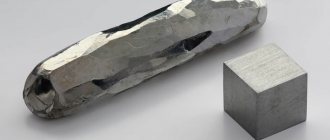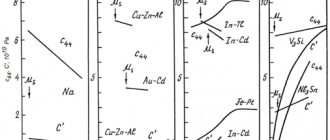Our world is full of amazing facts that are interesting to many people. The properties of various metals are no exception. Among these elements, of which there are 94 in the world, there are the most ductile and malleable, and there are also those with high electrical conductivity or a high resistance coefficient. This article will talk about the hardest metals, as well as their unique properties.
Iridium
Iridium ranks first in the list of metals that are distinguished by the greatest hardness. It was discovered at the beginning of the 19th century by the English chemist Smithson Tennant. Iridium has the following physical properties:
- has a silvery-white color;
- its melting point is 2466 °C;
- boiling point – 4428 oC;
- resistance – 5.3·10−8Ohm·m.
Because iridium is the hardest metal on the planet, it is difficult to process. But it is still used in various industrial fields. For example, it is used to make small balls that are used in pen nibs. Iridium is used to make components for space rockets, some parts for cars, and more.
Iridium
Very little iridium occurs in nature. Findings of this metal are a kind of evidence that meteorites fell in the place where it was discovered. These cosmic bodies contain significant amounts of metal. Scientists believe that our planet is also rich in iridium, but its deposits are closer to the Earth's core.
Industrial applications of titanium
The hardest metal has a fairly wide range of applications in many industries. Amorphously arranged atoms provide titanium with the highest level of tensile and torsional strength, good impact resistance, and high magnetic qualities. The metal is used to make air transport bodies and missiles. It copes well with the enormous loads that cars experience at great heights. Titanium is also used in the production of hulls for submarines, as it can withstand high pressure at great depths.
In the medical industry, metal is used in the manufacture of dentures and dental implants, as well as surgical instruments. The element is added as an alloying additive to some grades of steel, which gives them increased strength and resistance to corrosion. Titanium is well suited for casting as it produces perfectly smooth surfaces. It is also used to make jewelry and decorative items. Titanium compounds are also actively used. Dioxide is used to make paints, whitewash, and is added to paper and plastic.
Organic titanium salts are used as a hardening catalyst in paint and varnish production. Various tools and attachments for processing and drilling other metals are made from titanium carbide. In precision engineering, titanium aluminide is used to produce wear-resistant elements that have a high safety margin.
The hardest metal alloy was obtained by American scientists in 2011. Its composition included palladium, silicon, phosphorus, germanium and silver. The new material was called "metallic glass". It combines the hardness of glass and the plasticity of metal. The latter prevents cracks from spreading, as happens with standard glass. Naturally, the material was not put into widespread production, since its components, especially palladium, are rare metals and are very expensive.
At the moment, the efforts of scientists are aimed at searching for alternative components that would preserve the properties obtained, but significantly reduce the cost of production. However, some parts for the aerospace industry are already being produced from the resulting alloy. If alternative elements can be introduced into the structure and the material becomes widespread, then it is quite possible that it will become one of the most popular alloys of the future.
- A common belief about hardness is diamond or damask steel/damascus steel. If the first mineral is superior to all simple substances existing on Earth that nature has created, then the amazing properties of blades made of rare steel are due to the skill of swordsmiths and additives from other metals. Many technical alloys, used, for example, for the production of super-hard cutters in the engineering industry, creating durable, reliable tools with unique properties, are associated with these additives in the usual symbiosis of iron and carbon, in short, traditionally called steel - chromium, titanium, vanadium, molybdenum, nickel. When readers ask what the hardest metal in the world is, they are bombarded with a barrage of conflicting information on the pages of websites. In this role, according to the authors of various articles, either tungsten or chromium, or iridium with osmium, or titanium with tantalum.
- Very high refractoriness.
- Resistant to corrosion and oxidation even when heated to high temperatures.
- Resistant to concentrated acids and other aggressive compounds.
- 10 -11% is their content in the solid shell of the planet.
- The total amount of pure metal produced per year is within the following limits: 4 tons for iridium, 1 t for osmium.
- The price of osmium is approximately equal to the price of gold.
In order to get through the jungle of not always correctly interpreted, albeit accurate facts, it is worth turning to the original source - the system of elements contained both in the composition and in other cosmic objects, left to humanity by the great Russian chemist and physicist D.I. Mendeleev. He had encyclopedic knowledge, made many scientific breakthroughs in knowledge about the structure, composition, and interaction of substances, in addition to the famous table based on the fundamental periodic law he discovered, named after him.
The planets closest to the Sun - Mercury, Venus, Mars, together with our planet, are classified as one - the terrestrial group. There are reasons for this not only among astronomers, physicists and mathematicians, but also among geologists and chemists. The reason for such conclusions among the latter is, among other things, the fact that they all mainly consist of silicates, i.e. various derivatives of the element silicon, as well as numerous metal compounds from Dmitry Ivanovich’s table.
In particular, our planet mostly (up to 99%) consists of ten elements:
But man, in addition to the iron and alloys based on it necessary for survival and development, has always been much more attracted to precious metals, often respectfully called noble metals - gold and silver, and later platinum.
According to the scientific classification adopted by chemists, the platinum group includes ruthenium, rhodium, palladium and osmium with iridium. All of them also belong to noble metals. Based on their atomic mass, they are conventionally divided into two subgroups:
The last two are of particular interest for our pseudo-scientific investigation on the topic of who is the hardest here. This is due to the fact that the large atomic mass compared to other elements: 190.23 for osmium, 192.22 for iridium, according to the laws of physics, implies a huge specific density, and, consequently, the hardness of these metals.
If dense, heavy gold and lead are soft, plastic substances that are easy to process, then osmium and iridium, discovered at the beginning of the 19th century, turned out to be fragile. Here it is necessary to remember that the measure of this physical property is that a diamond, which can be used to inscribe on any other hard material of natural or artificial origin without much effort, is also extremely fragile, i.e. It's fairly easy to break. Although, at first glance, this seems almost impossible.
In addition, osmium and palladium have many more interesting properties:
Therefore, along with platinum, including in the form of compounds with it, they are used in the production of catalysts for many chemical processes, high-precision devices, equipment, tools in the medical, scientific, military, and space sectors of human activity.
It is osmium and iridium, and scientists after research believe that this property is approximately equally given to them by nature, are the hardest metals in the world.
And everything would be fine, but not very good. The fact is that both their presence in the earth’s crust and, accordingly, the global production of these very minerals are negligible:
It is clear that these rare earth, expensive metals, despite their hardness, cannot even be used to a limited extent as raw materials for production; perhaps as additives to alloys, compounds with other metals to impart unique properties.
Ruthenium
The second position on our list goes to ruthenium. The discovery of this inert silvery metal belongs to the Russian chemist Karl Klaus, which was made in 1844. This element belongs to the platinum group. It is a rare metal. Scientists have been able to establish that there is approximately 5 thousand tons of ruthenium on the planet. It is possible to extract approximately 18 tons of metal per year.
Ruthenium
Due to its limited quantity and high cost, ruthenium is rarely used in industry. It is used in the following cases:
- a small amount of it is added to titanium to improve corrosion properties;
- its alloy with platinum is used to make electrical contacts that are highly resistant;
- ruthenium is often used as a catalyst for chemical reactions.
Alloys of the strongest metals
The addition of certain alloying elements to the metal at the time of melting and casting increases the mechanical and physical characteristics of the material. One of the technologies for producing the alloy is based on sintering cobalt powders and metal carbides. In essence, alloys are analogues of metals, but with modified characteristics of strength and hardness, which are determined by the size of the carbide grains in the structure, as well as the presence of certain alloying additives.
The strongest alloys are tungsten. They are refractory, able to withstand enormous loads and critically high temperatures. Tungsten alloys begin to melt at a temperature of 2780 degrees, and during machining the cutting edge can easily withstand up to 800 degrees. To create such alloys, cobalt and metal carbide are used in certain proportions. There are also alloys created on the basis of titanium carbides and carbonites. Particularly promising for metallurgy are alloys based on vanadium steel, the tensile strength of which reaches 5205 MPa. The strongest alloy known to date in the world consists of titanium and gold β-Ti3Au.
Separately, we can note steel alloys, which consist of iron and other elements, such as carbon. Although iron itself is not one of the strongest metals, as an alloy it shows excellent strength characteristics.
Tantalum
A metal called tantalum, discovered in 1802, takes third place on our list. It was discovered by the Swedish chemist A. G. Ekeberg. For a long time it was believed that tantalum is identical to niobium. But the German chemist Heinrich Rose managed to prove that these are two different elements. Scientist Werner Bolton from Germany was able to isolate tantalum in its pure form in 1922. This is a very rare metal. The largest deposits of tantalum ore were discovered in Western Australia.
Tantalum
Due to its unique properties, tantalum is a highly sought-after metal. It is used in various fields:
- in medicine, tantalum is used to make wire and other elements that can hold tissue together and even act as a bone substitute;
- alloys with this metal are resistant to aggressive environments, which is why they are used in the manufacture of aerospace equipment and electronics;
- tantalum is also used to create energy in nuclear reactors;
- the element is widely used in the chemical industry.
TOP 10 strongest metals in the world
The 8 indicators mentioned above are not the only correct formula for calculating the strength of metals.
There are 10+ auxiliary parameters that can also be included in the complex, but they will not bring significant changes to our top strength. Below we will analyze which metal is the strongest, and also look at the 10 strongest pure metals found in the world. Let's start from the weakest and get to the leader of strength at the end of the article. At the same time, we will outline the features of each of the substances + tell you in what areas they are used in order for 2020.
1) Tantalum
| Prevalence | ★★ (2.0 out of 5.0) | Overall industrial attractiveness ★★★ 3.0 |
| Price | ★★★★ (4.0 out of 5.0) | |
| Application | ★★★ (3.0 out of 5.0) |
In the periodic table it is referred to as “Ta”. Externally it is a silver + white tint and a dense oxide film. The discovery of the metal occurred in 1802 by Ekeberg, but the substance was obtained in its pure form only 42 years later, and this was done by the German Rose. With regard to industry, the first steps in this direction were taken in general in 1922, and its active spread began during the Second World War.
Scope of application of tantalum:
- when creating alloys with high resistance to corrosion and heat;
- laboratory glassware and corrosion-resistant technical equipment in the chemical industry;
- heat transfer equipment for nuclear power systems;
- surgical consumables. Tantalum wire is used to stitch together nerve tissue;
- as a constituent element of cryotrons;
- as a decorative element for jewelry.
Tantalum is classified as a metal with a low level of distribution in nature. If we take the earth's surface as a reference point, its share in the earth's crust is less than two millionths of a percent - this also affects the cost of pure metal. For one gram of tantalum, prices on the market range from $250. The main physical properties of the metal are a high melting point (3000+ degrees) and ductility (like gold), although the material has very few competitors in terms of hardness.
2) Beryllium
| Prevalence | ★★★★ (4.0 out of 5.0) | Overall industrial attractiveness ★★★★ 4.0 |
| Price | ★★★★ (4.0 out of 5.0) | |
| Application | ★★★★ (4.0 out of 5.0) |
The chemical element was first discovered in 1798 by the Frenchman Vauquelin. The average volume in the earth's crust is from 4 grams per ton. If we are talking about alkaline rocks, then its content increases to 70 grams per ton. The main deposits of beryllium are areas near volcanoes, where it replaces material such as silicon in igneous rocks.
Properties of beryllium:
- Mohs hardness 5.5 points;
- high fragility;
- high modulus of elasticity;
- upon contact with air it becomes covered with an oxide film;
- record holder for sound conductivity - from 12,500 meters per second;
- low reactivity.
In 2021, the main suppliers of beryllium are America, China and Kazakhstan. The total beryllium production of all other countries is less than 1%. The average annual metal production is only 400,000 kilograms. In Russia, it is planned to launch a plant for the extraction of this metal, among other things, but for now the plant is at the development stage, and it is not a fact that it will be launched at all.
The metal has proven itself well in X-ray technology, nuclear energy, acoustics, and even in the development of aerospace technology. Due to its high thermal conductivity coupled with its strength, the material is often used for the manufacture of laboratory crucibles and other specialized components where the listed properties of the metal are required.
Purpose and methods of metal spraying
3) Uranus
| Prevalence | ★★★★ (4.0 out of 5.0) | Overall industrial attractiveness ★★★★ 4.0 |
| Price | ★★★★ (4.0 out of 5.0) | |
| Application | ★★★★ (4.0 out of 5.0) |
Uranium belongs to the actinide family and is a weakly reactive element of the periodic table.
People began to talk about uranium in earnest for the first time in 1789. In 1840, it was possible to isolate the first sample of a pure substance, and in 1896 the notorious radioactive decay was discovered, which served as a basis for the further use of the metal in the weapons field. Physical properties of uranium:
- heavy;
- glossy surface with a silver-white tint;
- in its pure form it has less strength than steel, which makes it more flexible;
- slight paramagnetic properties;
- melting point from 1,100 degrees.
We will not understand the chemical properties here, because to understand what is happening we will have to delve into the depths of nuclear energy. Let us just note that the main use of uranium in industry is the production of nuclear fuel. Uranium isotopes can be used for synthesis in industrial medicine, and their geological value is identifying the age of minerals or rocks.
The countries marked on the map concentrate 94% of all uranium production for industrial purposes. If we look at countries, the leading positions in terms of volumes are held by Kazakhstan, Australia and Canada, and Russia occupies a solid 4th place.
4) Iron/steel
| Prevalence | ★★★★★ (5.0 out of 5.0) | Overall industrial attractiveness ★★★★★ 5.0 |
| Price | ★★★★★ (5.0 out of 5.0) | |
| Application | ★★★★★ (5.0 out of 5.0) |
Iron itself does not have a high safety factor, but in combination with other metals, incredibly strong compounds can be obtained. That is why we added “/steel” in the table of contents. The fame of iron “Fe” has come to us since ancient times. The ancient Greeks were one of the first to use metal in everyday life, and this is 4 thousand years BC. In terms of content in the earth's crust, iron is one of the most common elements in the table - 5% in the crust, up to 12% in the mantle and up to 90% in the core.
Properties of iron:
- itself is ductile, but steel can be adjusted in terms of fragility at the level of strength;
- pronounced magnetic properties;
- polymorphism due to 4 crystal modifications;
- The metal begins to melt at 1,500+ degrees, and boils at 2,850+.
According to recent American research, world iron reserves amount to almost 180 billion tons. There are large deposits in Brazil, Australia, Sweden, India, Poland, and Ukraine. On Russian territory, iron is mined in Kursk. You could write a dissertation on the use of iron. Its share within the entire industry is 95%. The element is important not only in production, but also for the human body - it is a catalyst for the respiration process.
The essence of steel annealing technology, types and purpose
5) Titanium
| Prevalence | ★★★★ (4.0 out of 5.0) | Overall industrial attractiveness ★★★★ 4.5 |
| Price | ★★★★★ (5.0 out of 5.0) | |
| Application | ★★★★ (4.0 out of 5.0) |
Titan was simultaneously discovered by two scientists - the Englishman Gregor and the German Klaproth in 1791. The metal was first obtained in its pure form in 1825. This was done by the Swede Berzelius. Industrial use of the metal began only after 1940, when a patent was issued for its reduction from tetrachloride.
In terms of prevalence, the element closes the top 10. In the earth's crust, the titanium content is at the level of 0.5%. Large titanium deposits are in South Africa, Russia, Ukraine, Canada and the USA, but “in small ways”, the metal is mined in most developed countries.
Scope of application of titanium:
- an important element of alloys in aviation, shipbuilding and rocketry;
- as a material for reactors, pipelines and pumps in chemistry;
- the armor of the vests and the skin of the submarines is titanium;
- due to the physiological inertness of the metal, titanium is widely used in medicine, in the development of various prostheses and implants;
- as an additive in alloy steels.
The average cost of 1 kilogram of titanium starts at $6. The purer the metal, the more expensive it will cost. In terms of physical properties, it is a silvery-white metal with a melting point of 1,700 degrees. At temperatures below 70, the fragility of the metal increases. It is very plastic, and its strength is highly dependent on pre-treatment. According to Vickers, the hardness reaches 800 MPa.
6) Rhenium
| Prevalence | ★★ (2.0 out of 5.0) | Overall industry attractiveness ★★ 2.5 |
| Price | ★★ (2.0 out of 5.0) | |
| Application | ★★★ (3.0 out of 5.0) |
The name of the metal is due to the place where it was first mined - the Rhine River in Germany. The element belongs to the list of those that were predicted by Mendeleev. The official discovery of rhenium in its pure form dates back to 1928, and the transition to industrial production occurred after 1930. The installation produced about 130 kilograms of metal per year, and the agreed volume was quite enough to cover the world demand for this metal.
Properties of rhenium:
- extremely high density - 21 grams per cubic centimeter;
- rhenium can only be melted at temperatures above 3,200 Celsius;
- boiling point – 5,600+ degrees, which allows the metal to take a solid 2nd place in the heat resistance rating;
- refers to refractory metals;
- at room temperature has good plasticity;
- able to withstand repeated heating-cooling cycles without loss of strength.
In terms of distribution, rhenium is one of the rarest metals on earth. Its mass fraction is 7 * 10 to the power of minus 8 for the entire mass of the earth's crust. The main source of metal extraction is molybdenum ore. By the way, Russia has one of the largest deposits of this metal with reserves of almost 20 tons. However, rhenium here is also not pure, but as a component of the rhinite mineral. The price of one kilogram of rhenium is from 1000 to 10,000 dollars. The metal is used in the petroleum refining industry, electrical/electronics engineering and as an element in alloys in rocketry.
7) Chrome
| Prevalence | ★★★★ (4.0 out of 5.0) | Overall industrial attractiveness ★★★★★ 3.0 |
| Price | ★★★★ (4.0 out of 5.0) | |
| Application | ★★ (2.0 out of 5.0) |
No, this is not a browser, but a chemical element made of metals. The Mohs scale ranks chromium in the top five. It is second only to boron, tungsten and, of course, diamond. The first mention of a more or less pure substance was mentioned in 1797, when the Frenchman Vauquelin was able to obtain chromium carbide. One of the most important uses of chromium in industry is chrome plating of parts through electrolytic plating.
Physical properties of chromium:
- metal with a bluish tint and a volume-centered cubic lattice;
- at temperatures below 37 degrees, chromium becomes an antiferromagnet, and above it becomes a paramagnetic substance;
- According to Mohs, the hardness of chromium is estimated at 8.5 points out of 10;
- High purity chrome can be machined quite well;
- does not react with nitric and sulfuric acids;
- When burned at a temperature of 2000+ degrees, a greenish powder is formed - chromium oxide.
Chromium cannot be called rare in nature. The metal makes up about 3 hundredths of the mass of the earth's crust. It is not found in its pure form. The main compounds found in nature are chromite and crocoite. The largest chromium deposit is located in South Africa. Next comes Kazakhstan and Russia. The main chromium deposits on the territory of the Russian Federation are located within the Urals. The basic use of chromium is as an additive in alloy steels. The powder can increase the strength of the alloy by 2-3 times and add anti-corrosion properties to the material. That is why chrome plating of galvanic coatings is so popular in the Russian Federation.
 Iridium
Iridium
| Application | ★ (1.0 out of 5.0) | Overall industrial attractiveness ★★★★★ 2.0 |
| Prevalence | ★★ (2.0 out of 5.0) | |
| Price | ★ (1.0 out of 5.0) |
What Russian reviewers need to know first of all is that metal is put on a par with precious metals, and therefore its illegal storage, acquisition and sale within the Russian Federation is a criminal offense. The discovery of metal occurred in 1803. This was done by the English chemist Tennant. The origin of the name itself is from Greek, which in translation symbolizes a rainbow. The metal began to be called this because of the multi-colored salts that were formed in the precipitate during reactions with iridium.
What properties does iridium have:
- due to its high hardness, it is almost impossible to machine;
- the melting point of the metal is from 2,500+, and the boiling point is reached at a temperature of 4,450+;
- one of the best corrosion resistance;
- remains inert in air and when heated.
Iridium is not particularly important in industry. Spark plugs, electrode bases and other small items can be used with iridium, but due to its high cost, starting from $50 per gram, mass production of the specified parts is low-profit.
9) Osmium
| Application | ★★★ (3.0 out of 5.0) | Overall industrial attractiveness ★★★★★ 3.0 |
| Prevalence | ★★★ (3.0 out of 5.0) | |
| Price | ★★★★ (4.0 out of 5.0) |
The metal was discovered by the Englishman Tennant in 1803. It was obtained as a precipitate from the dissolution of platinum in aqua regia. In appearance, osmium is a blue-gray metal of high strength. High specific gravity + retention of gloss even when exposed to high temperatures, combined with a shade of blue, make the chemical element attractive in appearance. The mass fraction of osmium in nature is 5•10 to the −6 power% by mass.
Where can you find osmium:
- solutions with iridium;
- polymetallic ores;
- platinum minerals;
- in processing of gold ores.
The main points of osmium production are concentrated in Siberia and the Urals, if we are talking about the Russian Federation. A considerable amount of metal is also mined by the USA, Colombia, Canada and some countries in South Africa.
The prevalence of osmium in the earth's crust is 7 thousandths of a gram per ton, and it is obtained through the enrichment of raw materials from platinum metals through calcination at a temperature of 800 Celsius. The refractoriness of the metal allows it to be used in friction units, and due to its similar properties to precious metals, the element is used for jewelry.
Review video on the strongest metal on the globe:
10) Tungsten
| Application | ★★★★ (4.0 out of 5.0) | Overall industrial attractiveness ★★★★★ 4.0 |
| Prevalence | ★★★ (3.0 out of 5.0) | |
| Price | ★★★★★ (5.0 out of 5.0) |
The history of tungsten is murky. It was isolated back in 1750, but official recognition occurred only after 1780, when the Spanish chemists, the Eluard brothers, began to study the element seriously. In nature, the metal is distributed in impure form (mainly oxidized complex compounds), but as a clarke in the ratio of 1.3 grams per ton of earth mass. The largest tungsten deposits are Kazakhstan, China, the USA and Canada. Russia also has a couple of supply points. The annual production volume of the strongest metal in the world is up to 50,000 tons. To process tungsten, it is necessary to use the powder metallurgy method. The problem is the strength of the metal.
Chemical/physical properties of tungsten:
- density is 19.3 grams per cubic centimeter;
- the most heat-resistant metal in the world. It begins to melt after reaching a temperature of 2,450 degrees Celsius. Boiling point – 5,600 degrees (just think about it!);
- has paramagnetic properties;
- Brinell hardness 488 kilograms per square millimeter;
- conducts sound well - from 4300 meters per second.
The key area of tungsten is the basis of refractory metals in metallurgy. Look at the filament of a light bulb - it consists of an alloy with tungsten. It is impossible to imagine vacuum tubes, electrodes, and other heating elements where it is necessary to withstand high temperatures without tungsten.
Thus, the element is not only the strongest metal in the world, but also one of the indispensable components of everyday life and industry.
Chromium
Chromium is one of the hardest metals. It was discovered in Russia in 1763 in a deposit in the Northern Urals. It has a bluish-white color, although there are cases where it is considered a black metal. Chrome cannot be called a rare metal. The following countries are rich in its deposits:
- Kazakhstan;
- Russia;
- Madagascar;
- Zimbabwe.
Chromium
There are chromium deposits in other countries as well. This metal is widely used in various branches of metallurgy, science, mechanical engineering and others.
About metals in nature
The word “metal” came into Russian from German. Since the 16th century it has been found in books, although quite rarely. Later, in the era of Peter I, it began to be used more often, and then the word had the general meaning of “ore, mineral, metal.” And only during the period of M.V.’s activity. Lomonosov these concepts were differentiated.
In nature, metals are found quite rarely in their pure form. Basically, they are part of various ores, and also form various compounds, such as sulfides, oxides, carbonates and others. In order to obtain pure metals, and this is very important for their future use, they need to be isolated and then purified. If necessary, metals are alloyed - special impurities are added in order to change their properties. Currently, there is a division into ferrous metal ores, which include iron, and non-ferrous ores. Precious or noble metals include gold, platinum and silver.
There are metals even in the human body. Calcium, sodium, magnesium, copper, iron - this is a list of these substances that are found in the greatest quantities.
Beryllium
The fifth position in the list of the hardest metals goes to beryllium. Its discovery belongs to the chemist Louis Nicolas Vauquelin from France, which was made in 1798. This metal has a silvery-white color. Despite its hardness, beryllium is a brittle material, which makes it very difficult to process. It is used to create high-quality loudspeakers. It is used to create jet fuel and refractory materials. The metal is widely used in the creation of aerospace technology and laser systems. It is also used in nuclear energy and in the manufacture of X-ray equipment.
Beryllium
Silver
A precious metal of great importance to many high-tech industries. Of all the metals, silver has the highest electrical and thermal conductivity. According to this characteristic, it is superior to copper.
Due to its high cost, the metal is used only in a few industries, such as electronics. Silver plating of various circuits and semiconductor devices is essential for their proper functioning. In addition to electronics and jewelry, silver is widely used as an antibiotic coating in medical instruments and devices.
It is an excellent catalyst for most oxidation processes. During World War II, almost 13,000 tons of silver were used to enrich uranium.
7
Osmium
The list of the hardest metals also includes osmium. It is an element belonging to the platinum group, and its properties are similar to iridium. This refractory metal is resistant to aggressive environments, has a high density, and is difficult to process. It was discovered by the scientist Smithson Tennant from England in 1803. This metal is widely used in medicine. Elements of pacemakers are made from it, and it is also used to create the pulmonary valve. It is also widely used in the chemical industry and for military purposes.
Osmium
Hard metals with the highest density
Some of the hardest metals are also osmium and iridium.
These are substances from the platinum group; they have the highest, almost identical, density. Iridium was discovered in 1803. The metal was discovered by a chemist from England, Smithson Tennat, while studying natural platinum from South America. By the way, “iridium” is translated from ancient Greek as “rainbow”.
The hardest metal is quite difficult to obtain, since it is almost absent in nature. And often the metal is found in meteorites that fell to the ground. According to scientists, on our planet the content of iridium should be much higher. But due to the properties of the metal - siderophilicity - it is located at the very depths of the earth's bowels.
Iridium is quite difficult to process both thermally and chemically. The metal does not react with acids, even combinations of acids at temperatures less than 100 degrees. At the same time, the substance is subject to oxidation processes in aqua regia (this is a mixture of hydrochloric and nitric acids).
The iridium isotope 193 m 2 is of interest as a source of electrical energy. Since the half-life of the metal is 241 years. Iridium has found widespread use in paleontology and industry. It is used in making pen quills and determining the age of different layers of the earth.
But osmium was discovered a year later than iridium. This solid metal was found in the chemical composition of a precipitate of platinum, which was dissolved in aqua regia. And the name “osmium” comes from the ancient Greek word for “smell.” The metal is not subject to mechanical stress. Moreover, one liter of osmium is several times heavier than ten liters of water. However, this property has not yet been used.
Osmium is mined in American and Russian mines. Its deposits are also rich in South Africa. Quite often the metal is found in iron meteorites. Of interest to specialists is osmium-187, which is exported only from Kazakhstan. It is used to determine the age of meteorites. It is worth noting that just one gram of the isotope costs 10 thousand dollars.
Well, osmium is used in industry. And not in its pure form, but in the form of a hard alloy with tungsten. Produced from the substance of incandescent lamps. Osmium is a catalyst in the production of ammonia. Cutting parts for surgical needs are rarely made from metal.
Rhenium
The transition silver metal rhenium takes the seventh position on our list. The assumption about the existence of this element was made by D.I. Mendeleev in 1871, and chemists from Germany managed to discover it in 1925. Just 5 years after this, it was possible to establish the extraction of this rare, durable and refractory metal. At that time, it was possible to obtain 120 kg of rhenium per year. Now the amount of annual metal production has increased to 40 tons. It is used for the production of catalysts. It is also used to make electrical contacts that can self-clean.
Rhenium
The hardest pure metal
The hardest of the purest metals on the planet is chromium.
It lends itself perfectly to mechanical processing. The bluish-white metal was discovered in 1766 in the vicinity of Yekaterinburg. The mineral was then called “Siberian red lead.” Its modern name is crocoite. A few years after the discovery, namely, in 1797, the French chemist Vauquelin isolated a new metal from the metal, already refractory. Experts today believe that the resulting substance is chromium carbide. The name of this element is derived from the Greek “color”, because the metal itself is famous for the variety of colors of its compounds. Chromium is quite easy to find in nature and is common. You can find the metal in South Africa, which ranks first in production, as well as in Kazakhstan, Zimbabwe, Russia and Madagascar. There are deposits in Turkey, Armenia, India, Brazil and the Philippines. Experts especially value certain chromium compounds - chromium iron ore and crocoite.
Tungsten
Silver-gray tungsten is not only one of the hardest metals, it also leads in refractoriness. It can only be melted at a temperature of 3422 °C. Due to this property, it is used to create incandescent elements. Alloys made from this element have high strength and are often used for military purposes. Tungsten is also used to make surgical instruments. It is also used to make containers in which radioactive materials are stored.
Tungsten
How are metals produced?
Metal-containing ores are considered the source of these most necessary substances for all modern humanity. To find out their exact location, certain search methods are used, which are based on exploration and study of deposits. Metals are obtained as follows:
- Ore deposits are developed by open-pit or quarry, as well as underground or mine. Combined methods are possible.
- Ore beneficiation is the separation of useful components from raw materials, so-called ore concentrates.
- Extraction of metals from enriched ores by chemical or electrolytic reduction using high temperatures or aqueous chemistry.
- Most often, metals are smelted, the ore and a reducing agent are heated to very high temperatures. For iron, carbon is usually used.
Depending on their further use, metals are divided into groups:
- Construction materials. Both the metals themselves and their alloys with significantly improved properties are used. In this case, strength, impermeability to liquids and gases, and homogeneity are valued.
- Materials for tools, most often referring to the working part. Tool steels and hard alloys are suitable for this purpose.
- Electrical materials. Such metals are used as good conductors of electricity. The most common of them are copper and aluminum. They are also used as materials with high resistance - nichrome and others.
Uranus
One of the hardest metals is uranium. It was discovered in 1840 by the chemist Peligo. D.I. Mendeleev made a great contribution to the study of the properties of this metal. The radioactive properties of uranium were discovered by the scientist A. A. Becquerel in 1896. Then a chemist from France called the detected metal radiation Becquerel rays. Uranium is often found in nature. The countries with the largest deposits of uranium ore are Australia, Kazakhstan and Russia.
Uranus
Copper
One of the few elements that occurs naturally in a usable metallic form that does not need to be extracted from any mineral ore.
Thanks to this feature, people could use copper even before 7000 BC. In 3500 BC, copper was fused with tin to make bronze. For the first time in human history, one metal was fused with another. Currently, the bulk of global copper production is used in cable wires and electrical circuits. Used in the production of plumbing and roofing.
A person contains from 1.4 to 2.1 mg of copper per 1 kg of body weight. Excessive copper accumulation in the liver can lead to severe organ damage and neuropsychiatric symptoms. This condition is known as Wilson's disease.
4
Titanium
The final place in the top ten hardest metals goes to titanium. For the first time this element was obtained in its pure form by the chemist J. Ya. Berzelius from Sweden in 1825. Titanium is a lightweight silver-white metal that is highly durable and resistant to corrosion and mechanical stress. Titanium alloys are used in many branches of mechanical engineering, medicine and the chemical industry.
Titanium
Physico-chemical parameters of titanium
This element was first isolated completely without impurities in Sweden in 1825. This was done by a chemist with the famous surname Berzelius. Titanium is a light weight metal with a silvery-white hue. It has a low molecular weight. It is equal to only 22. This element has the following characteristics:
- Density - while the material is in a solid state before reaching a boiling point of 4.51 g / cu. cm. In the form of a liquid, the density has a different value - 4.12 g/cc
- Melting parameters - 1668°C.
- Boiling parameters - 3227°C.
- Titanium has little elasticity, which is considered its significant drawback.
- Hardness on the HB scale has an index of 103. It can vary depending on the presence of impurities in the substance and reach higher values.
- Under standard conditions, the metal in question practically does not rust, which is its undeniable advantage.
- According to biological indicators, it is a completely inert material, therefore it is actively used in medicine. Inertness may decrease with increasing temperature. For example, at +200°C, the metal successfully absorbs hydrogen and changes all its characteristics.
- Conducts current poorly and poorly.
If we take the MOOCA scale as a sample, titanium has a hardness rating of 4.5. This indicates that it is not the hardest metal. But of the available solids, it is used most often.
Application of titanium
This substance has received very wide use in almost all areas of industry. At the moment, titanium is successfully used:
- Aviation industry - many aircraft parts are exposed to high temperatures and strong deforming forces. That is why parts of the chassis, rivets, and various power elements of the body are made of titanium.
- Space technology. They also produce many spacecraft parts, especially their skins.
- Shipbuilding.
- Oil and gas industry. Here titanium is used for the manufacture of drilling pipes and high-pressure pumps.
- Construction. Here, solid metal is needed for various types of building cladding, roofing, and monuments.
- Medicine - many types of prostheses, as well as instruments.
- Sports - equipment, parts for bicycles, horizontal bars, sports accessories.
- Production of chemicals. The material simply cannot be replaced in cases where you need a durable substance that will not react with acids. Therefore, in the chemical industry, a wide variety of exchangers, structures and pipes are made from titanium.
For all its hardness, the material is light in weight. Therefore, the use of this substance is so widespread in all areas of industry. It does not wear out or deform for a long time.
See also: All about the most expensive in the world
Why is graphene the material of the future?
Graphene is the thinnest and strongest material known to man.
Graphene is the strongest material known to man. Being transparent, graphene consists of a single-layer carbon atom arranged in a triangular lattice and is the main building block of charcoal, graphite and carbon nanotubes. Graphene is 200 times stronger than steel. The variety of chemical and physical properties of this strongest material on Earth is due to the crystal structure and chemical bonding of the carbon atoms that make up graphene. This amazing material is used in the aerospace and automotive industries. Of course, graphene is not vibranium, but it is quite capable of competing with it, given that in the future, with the help of graphene, scientists will probably make a huge number of different discoveries. So, with the help of this ultra-strong and thin material, scientists will be able to restore broken bones and even prevent fractures.











